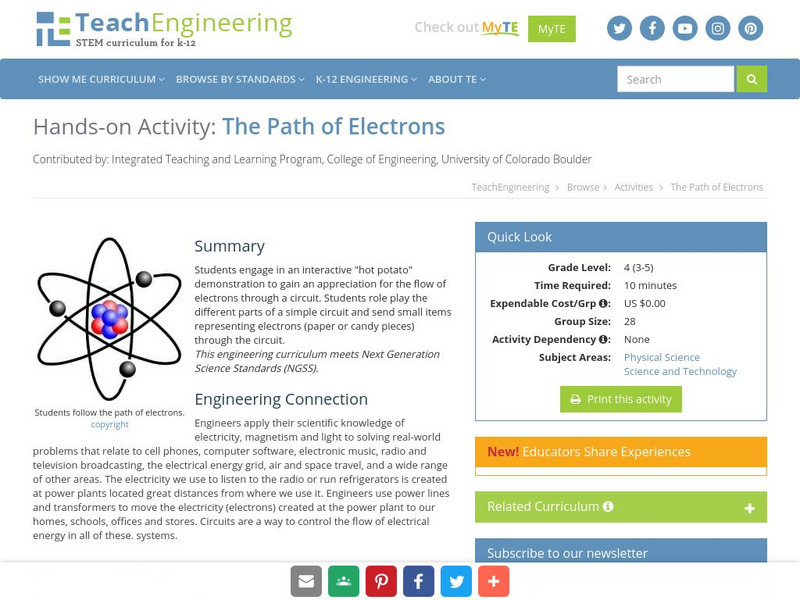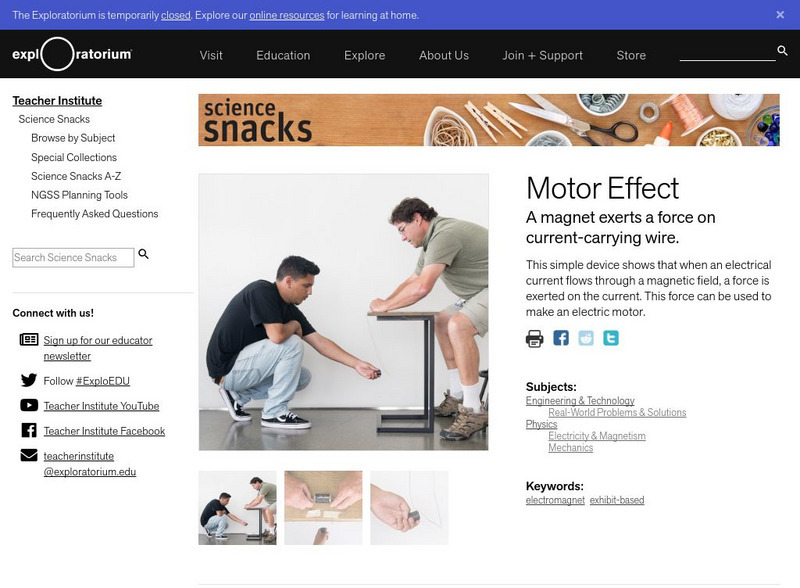National High Magnetic Field Laboratory
Magnet Academy: Wheatstone Bridge
This circuit is most commonly used to determine the value of an unknown resistance to an electrical current.
National High Magnetic Field Laboratory
Magnet Academy: Transmission Lines
Electricity goes through some ups and downs on its way from the power plant to your house. See how it works in this interactive activity.
National High Magnetic Field Laboratory
Magnet Academy: Wheatstone Bridge 1843
Read about the device used for measuring resistance in a circuit which was discovered in 1843, but had been invented a decade earlier. The inventor's name was not Wheatstone.
National High Magnetic Field Laboratory
Magnet Academy: William Crookes
English scientist William Crookes was very innovative in his investigations with vacuum tubes and designed a variety of different types to be used in his experimental work. Crookes tubes are glass vacuum chambers that contain a positive...
CK-12 Foundation
Ck 12: Electric Current
[Free Registration/Login may be required to access all resource tools.] The definition of electric current is explained and how to calculate an electric current. Includes links to resources for learning more about electricity, i.e., a...
Famous Scientists
Famous Scientists: Georg Ohm
Find out about the German physicist and mathematician whose work in the field of electrical current shaped the study of electricity.
TeachEngineering
Teach Engineering: The Path of Electrons
Students engage in an interactive "hot potato" demonstration to gain an appreciation for the flow of electrons through a circuit. Students role play the different parts of a simple circuit and send small items representing electrons...
TeachEngineering
Teach Engineering: Lights Out!
This lesson introduces the concept of electricity by asking students to imagine what their life would be like without electricity. Two main forms of electricity, static and current, are introduced. Students learn that electrons can move...
CK-12 Foundation
Ck 12: Physical Science: Direct and Alternating Current
[Free Registration/Login may be required to access all resource tools.] Describes the difference between direct current and alternating current.
CK-12 Foundation
Ck 12: Physical Science: Thermal Conductors and Insulators
[Free Registration/Login may be required to access all resource tools.] Thermal conductors and insulators and the ways they are used.
Exploratorium
Exploratorium: Science Snacks: Motor Effect
"A magnet exerts a force on current-carrying wire." This simple device shows how magnets affect wires with current in them, the basis of the electric motor. If you see, feel and understand this, the electric motor becomes very clear.
PBS
Pbs: Rough Science: Island Power Plant
Learn how to create electricity and your own electrical gadgets! Site provides users with information on how to make a battery, flashlight, buzzer an electric motor.
E-learning for Kids
E Learning for Kids: Science: Greece: What Can Electricity Do?
Alex is an actor in a play. Help him figure out which items use electricity so he can make sure everything is ready for the play.
Oswego City School District
Regents Exam Prep Center: Electricity: The Mouse Cheese Analogy
This page uses a mouse and cheese analogy to show the relationships involved in electricity through currents and charges. Among the topics covered by the analogy are voltage, resistance and electromagnetism.
Physics Aviary
Physics Aviary: Practice Problems: Rl in Ac Problem
Determine the rms current and voltage in an RL circuit powered by an AC power supply.
Physics Aviary
Physics Aviary: Practice Problems: Rlc in Ac Problem
Determine the rms current and voltage in an RLC circuit powered by an AC power supply.
Exploratorium
Exploratorium: The Tinkering Studio: Circuit Boards
Some history behind the function of the circuit board, with a guided activity guide for students to download.
Science Struck
Science Struck: Chart of Electrical Symbols With Their Meanings
A useful list of electrical symbols that are used in schematic diagrams. Each symbol is accompanied by its name and a caption stating its function.
Science Struck
Science Struck: Lcr Meter Working Principle and Uses
Explains what an LCR meter is and how it is used to measure the inductance, capacitance, and resistance of a circuit. Lists the different parameters of a circuit that it measures, describes two types of LCR meters, and gives definitions...
Physics Aviary
Physics Aviary: Simple Circuit Lab
This lab is designed to have students investigate the relationships between voltage, resistance and current in a circuit with only one passive component. The batteries in this simulation can be varied from ideal batteries to batteries...
Physics Aviary
Physics Aviary: Rail Gun Lab
This lab was designed to have students test the factors that affect the acceleration of a metal bar that is carrying a current through a magnetic field.
Physics Aviary
Physics Aviary: Magnetic Induction Lab
This lab was designed to have students test the things that can induce a current in a coil of wires. This lab is a purely quantitative lab.
Physics Aviary
Physics Aviary: Induced Current Lab
This lab was designed to have students test the factors that determine how much current is induced in a circuit when area of the circuit is changed. This lab is a quantitive lab that supplements the lab on magnetic flux.














